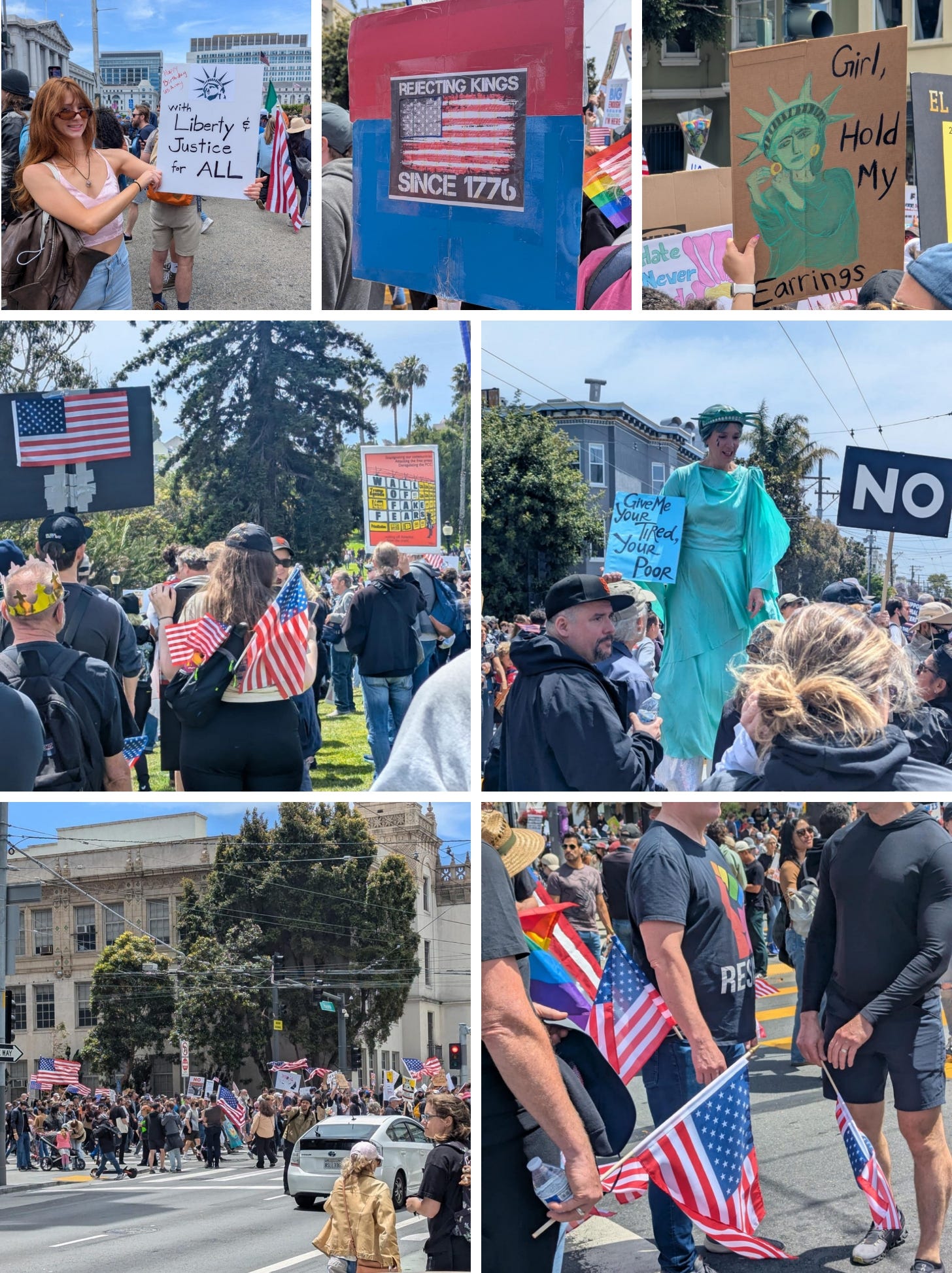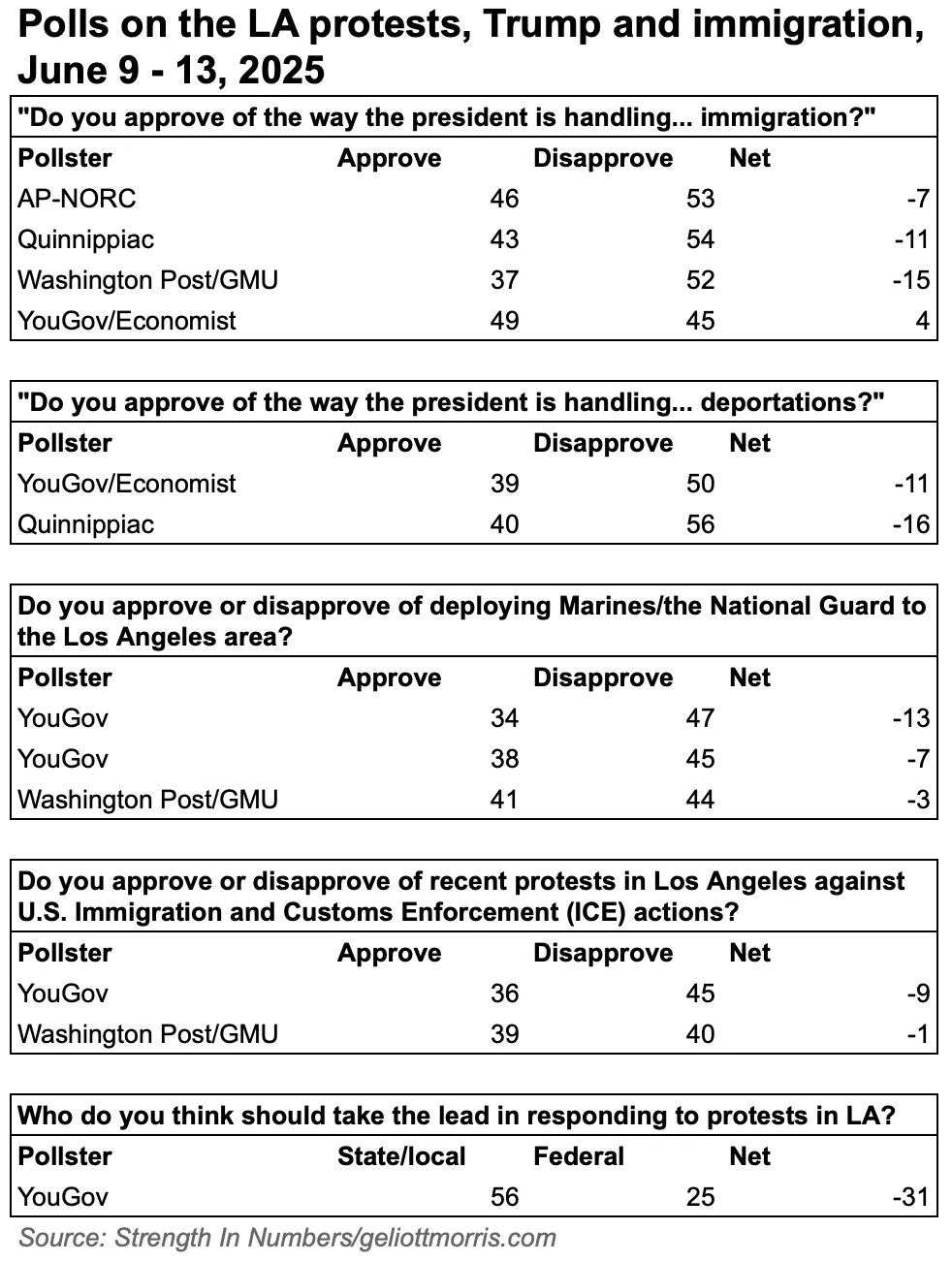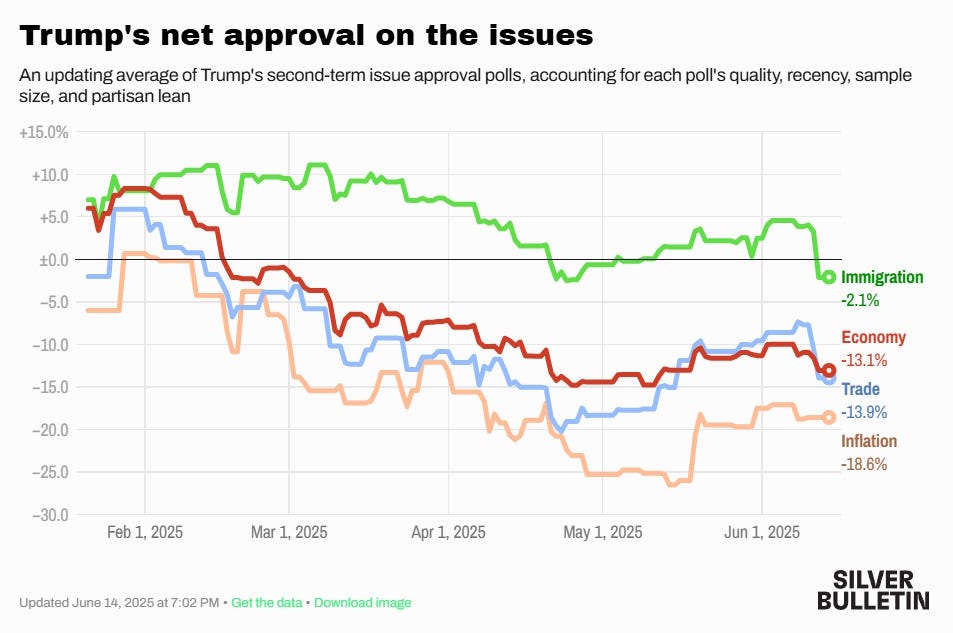|
I went to a protest today, for the first time in years. It was the “No Kings” protest in San Francisco, part of a nationwide series of protests against Donald Trump’s authoritarianism. The protests reportedly drew about 5 million people across the country — about the same as the Women’s March in 2017.
In almost every city, protests were completely peaceful — the only city to see significant violent clashes between protesters and police was Los Angeles, where leftist career-activists have gathered in recent days. Certainly, the SF protest I attended was totally nonviolent — I didn’t even see a single police officer. No stores were looted, no windows smashed, no cars overturned, no bricks thrown.
This was also the single most patriotic protest I’ve ever been to. Tons of people were carrying American flags — they absolutely overwhelmed the number of Palestine, Mexico, trans, and other flags. Many of the signs referenced the Constitution, the Statue of Liberty, or the American Revolution of 1776:

Here are some images of other protests from around the country; you can see they all look pretty much the same as the one in San Francisco.
Notably, there was none of the angry energy and racial grievance of the BLM protests of summer 2020, nor the anti-Americanism of the Palestine protests. There was no 1619 or 1948, only 1776. It was all just liberty and democracy and the Constitution. My overpowering impression was that this was the country I grew up in. These were the things that Americans valued — or at least, said they valued — when I was young.
It was a stunning victory for message discipline among the anti-Trump opposition. The current cycle of protest kicked off with small but violent riots against ICE in Los Angeles, in which a few rioters waved Mexican flags over burning cars. Afterward, many liberal commentators — including myself — denounced the imagery of using Mexican flags to protest mass deportations, and called for protests to remain peaceful.
A lot of progressives raged at us liberal tone police on social media, declaring that protesters should fly whatever flag they damn well choose, and that violence was an acceptable mode of resistance against fascism. The Washington Post ran an op-ed defending the use of the Mexican flag, and the New York Times called it a potent protest symbol. And yet the tone policing worked. I saw almost no Mexican flags in today’s demonstration, and the No Kings protests remained peaceful.
The result has been something of a public relations coup. The surprisingly large, peaceful, and patriotic protests compared favorably to Trump’s birthday military parade, which was poorly attended, dismal, and boring (and somehow included weird ads for Coinbase). Most Americans were leery of the parade, which seemed like the kind of self-glorifying, wasteful, tasteless display that a tinpot dictator would do — the perfect foil to a protest movement calling itself “No Kings”.
I’m also starting to develop a nuanced understanding of the relationship between riots, tone policing, and peaceful protest. In 2020, widespread rioting — although not nearly as bad as in the 1960s or L.A. 1992 — seemed to do long-term damage to the progressive cause in America, and spelled the end of the BLM movement. Certainly, research seems to show that riots are usually counterproductive — people don’t like chaos in the streets.
And yet it seems as if it might have partially been the threat of urban disorder that caused Trump to blink and back off on the most egregious of Stephen Miller’s aggressive deportation efforts. Although the justification he gave for his latest climbdown was economic, the timing suggests that the small L.A. riots might also have spooked him:
President Trump admitted Thursday that his own immigration crackdown is gutting key American industries — and pledged that “changes are coming” to the White House’s policies…In a post on Truth Social, Trump acknowledged that his deportation campaign is hurting key sectors of the American economy, including farming and hospitality.
“Our great Farmers and people in the Hotel and Leisure business have been stating that our very aggressive policy on immigration is taking very good, long time workers away from them, with those jobs being almost impossible to replace,” Trump wrote…“This is not good. We must protect our Farmers, but get the CRIMINALS OUT OF THE USA. Changes are coming,” he said.
Trump addressed the Truth Social post later Thursday afternoon, telling reporters at the White House: “Our farmers are being hurt badly by, you know, they have very good workers. They’ve worked for them for 20 years.”…“They’re not citizens, but they’ve turned out to be, you know, great. And we’re going to have to do something about that,” Trump said of undocumented migrants…“We can’t take farmers and take all their people and send them back because they don’t have maybe what they’re supposed to have, maybe not. And you know what’s going to happen and what is happening?”
The president added that migrant laborers have in some cases “been there for 20, 25 years and they’ve worked great. And the owner of the farm loves them and everything else.”…“And then you’re supposed to throw them out and you know what happens? They end up hiring the people, the criminals that have come in, the murderers from prisons and everything else.”…Trump said that “we’re going to have an order on that pretty soon.”
But if the overall anti-Trump resistance movement hadn’t stood up and aggressively tone-policed the rioters, the victory might well have been short-lived. If instead of photos of people carrying American flags down the street, the news had been filled scenes of smashed and looted storefronts from around the country, it seems likely that there would have been a backlash, resulting in more durable support for ICE.
But the riots and the rebellious anti-American message on display in L.A. on that first day were swiftly extinguished, and replaced with something much more appealing to the general public. As a result, Americans’ irritation with rioters never had the chance to blossom into full-fledged backlash. Instead, their disquiet with Trump’s intrusive new approach to deportations, and his heavy-handed use of the Marines to quell dissent, was allowed to shine through:
So I think my new, nuanced position is that one key function of peaceful protests — and of tone-policing — is to present the protest movement as a moderate alternative, successfully holding back the darkest impulses of rage bubbling up from the grassroots.
In any case, it’s working. Immigration is Trump’s best issue, but since the new ICE sweeps and the protests against them began, Trump’s approval on immigration has gone underwater:


